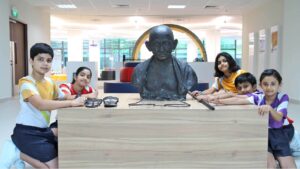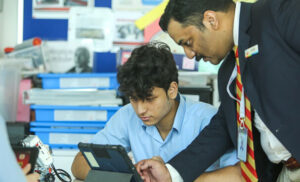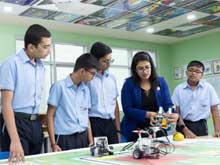Two years ago when the pandemic struck, we didn’t imagine the extraordinary ways in which it would transform our lives. Not only were we forced to stay home, but also work and study from home: a scenario that was way beyond our imagination. The idea, that the kids would be forced to stay indoors 24×7 and that their homes would be converted into online schools, felt overwhelming.
Today, two years since, our new lifestyle has changed us so drastically that work and education have taken on a hybrid avatar. There is a tussle between traditional and online schooling and kids and adults wonder which of the two they prefer.
Traditional and online school learning are two very different formats of education. Each has its own merits and demerits and it is difficult to pick the best out of the two.
What is Traditional Learning?
Traditional learning is classroom learning that has educated us for generations. The teacher in the classroom provides information and imparts knowledge through books and teaching aids. They ensure that their students imbibe all the information provided to them and are physically present to clear their doubts and rectify their mistakes.
The teacher is the primary source of information and the students can approach them for any difficulties related to their studies. The teacher also expects the students to further deepen the knowledge they gained through exercises that they are expected to do at home.
The students do get help with their studies from their parents, but ultimately, they turn to their teachers for any added support or assistance in understanding concepts they find difficult.
In traditional learning, the teacher can gauge which students have been able to comprehend the concepts and which students face difficulty in grasping the topic taught in class. This is one of the biggest advantages of face-to-face learning – the education system we have been following all these years.
What is Online Learning?
Online learning takes place over the internet, which is an online school. It is how children at the International schools in Abu Dhabi and the rest of the world have been learning and imbibing information over the past two years. It is akin to long-distance education, where the teacher isn’t physically present but provides information and knowledge online.
However, the teacher has no way of knowing how many students pay attention during the lecture, how many students understand the concepts taught in the virtual class, and how well the knowledge will be retained by them in the absence of a physical setting.
The students do have the help of the internet to solve their problems, or they turn to their parents for help, but it doesn’t make up for the presence of the teacher who is better trained to deal with their questions and doubts. The lack of social interaction proves to be the downside in the case of online learning.
However, it does offer flexibility in terms of place and time as students can work on their lessons anywhere and anytime, with the help of internet connectivity. The internet also makes them proficient in the use of technology, which is essential in today’s world.
Also Read: Important Values to Teach a Child
Difference Between Traditional and Online Learning
There is a huge difference between traditional and online learning:
1. Setting and Schedule
Online learning takes place in the virtual world and traditional learning takes place in the physical world at a set place and a set schedule. Students at an online school can attend their classes from any place, unlike traditional learning where students have to attend their schools and assemble in their classrooms to attend their lectures.
2. Source of Information
At online schools, the primary source of information is the internet, while in traditional learning, the teacher is the provider of knowledge.
3. Reliance on Technology
Online learning expects students to be techno-savvy and independent, while in traditional learning, the students are dependent upon their teachers to a great extent as the teacher is always there to solve their problems and provide information.
4. Social Interaction
In online learning, there is limited interaction between students and teachers. Students have to rely on the limited time they get to discuss their problems with their teacher, or socialize with their classmates.
5. Time Management
Online learning requires time-management skills while traditional learning happens at a fixed place and follows a fixed timetable. Students at a traditional school attend classes diligently, complete their work on time, and share it with their teachers on time.
In online learning, students are often laid back, especially younger students, as they don’t need to get ready for school and step outdoors to attend classes. Strategies and tips for time management for secondary school students will help them to focus on their academic performance.
6. Effectiveness
Traditional learning is ideal for every subject as well as conducting practicals or examinations. The same can’t be said about online learning, which often takes the seriousness out of examinations and the excitement out of laboratory practicals.
Online Learning: A Necessity in Today’s World
Online learning became a necessity in the post-COVID scenario. Keeping in mind the need to stay safe and continue with the learning process, schools all over the world moved their operations online.
The International schools in Abu Dhabi too obtained the necessary permission from their government to begin online schooling to ensure the students didn’t miss out on their studies.
As spending long hours in front of the screens is harmful to students, schools have taken the necessary steps to ensure that the students stay engaged at home, complete their syllabus on time, and also participate in the activities planned for them in a limited period.
With proper planning, communication, preparation, and familiarizing themselves with technical knowledge, schools chalked out a program that has helped students stay on track.
The schools have managed to keep their students creatively engaged by giving them ample breaks between classes, and planning interesting extracurricular activities to ensure their keen participation.
Conclusion
The pandemic taught us how uncertain life can be. It also taught us that change is the only constant. Although traditional learning beckons us after two years of staying indoors, online learning is the need of the hour. Only time will tell us what the future holds for our students, but for now, online learning is here to stay, at least until we win over the virus and get it under control.




























